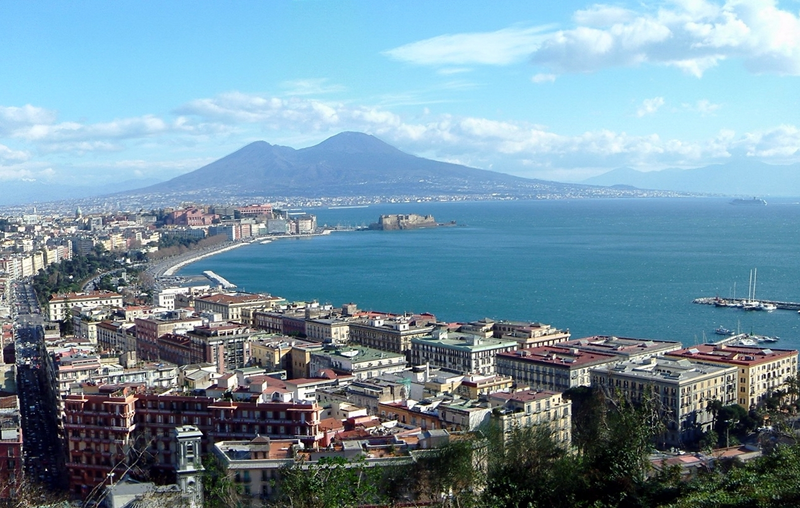I rode the train through Austria and Germany to Napoli (Naples), Italy. In Austria, little villages perched on verdant hills and nestled in valleys reflected the sunlight. It was like living in a travel video. Further on, red roofs glistened from the rain atop white, beige and yellow walls. The occasional dark red or bright blue walls on a house or café stood out. From my vantage point, viewing them from the train window, they all looked freshly painted and exuded prosperity — contrary to the publicized state of the European economy. When we rolled into Germany, the white, wispy clouds of Austria gave way to dark, threatening clouds, drifting down to cover the hilltops and release their moisture. Even in Semi-darkness the villages retained their Disneyland appearance. But my travel adventures were about to take this baby boomer to something else.
As I walked out of the Naples train station most of the businesses were closed and there were few people on the streets. The streets on the way to my hotel were dirty: trash blew around in the wind and the buildings all needed a paint job or more. The cars parked on the sidewalks and I was irritated that I had to pull my suitcase down the street. They didn’t stop for pedestrians, even when they had a red light; the drivers were unbelievably aggressive.
When I had a good night’s sleep and walked out of my hotel the next day, I saw a different Naples. I realized that I had arrived on a Sunday afternoon when most establishments were closed and people stayed home, and there was a soccer game between Spain and Italy on television. On Monday morning, the streets were crowded with busy, happy people, and the stores and cafes were open. The narrow alleys that dated back to the Renaissance were appealing, and most of the trash had been picked up during the night or early morning. Eventually, I learned that the street cleaners don’t work on Sunday.
I found picturesque cafes with inexpensive cappuccino, beer and wine, and the pizza was inexpensive. Every type of merchandise was sold in both high-end stores and on bargain tables outside. By that afternoon, I did not regret that my hotel reservation in Naples was for three nights.
If Paris has a café on every corner, Naples has a pizza joint on every corner. For my dinner the first night, I found a fine, inexpensive restaurant that served food besides only pizza. There, I ate the most amazing pasta with a sauce of tomato, basil and garlic — richer with flavor than I had ever tasted.
Naples is the city that invented pizza. The next day I found the ultimate pizza at the famous di Mateo. It was a three-story building with the pizza oven on the first floor and tables on the top two. Each “room” was no more than 12 by 14 feet. It had walls that had not been painted for decades and plain wood floors that had probably never been refinished. But, oh the aromas.
The first important feature of great pizza is a light crust, and di Mateo’s crust was the lightest I had every enjoyed. They offered more than 30 different pizzas from the simple Marguerite to those with a half dozen exotic ingredients. The flavors of the ingredients matched their aromas. The simple pizzas started at 2.50 euro and the most expensive were 6 euro. A glass of wine was 2 euro. No matter how busy they were, my pizza came within 10 minutes. I had their pizza for a lunch and two dinners in three days. A week or so later, passing through Naples for a night, I ate at di Matteo again. I couldn’t get enough of their pizza.
On my second day in Naples I encountered an interesting southern Italian cultural trait when I needed directions to a restaurant. A young man and woman were standing on the corner, apparently waiting for a bus, so I asked the woman for directions. I chose to ask the woman because I had found that more women speak English. As I began my question, the young man immediately moved closer to her in a protective way (I am 71 years old and rather small and thin), interrupted me and asked, “What do you want?” I told him, and he gave me directions. The woman never spoke. Throughout my stay of about two weeks in the south of Italy, I found it nearly impossible to engage a young woman in conversation, and it was rare to see a woman on the street alone, unless she was riding a scooter or motorcycle or was a foreigner.
The nicest and most intriguing street in Naples I did not find until my last day there, Toledo. It rivals Rodeo Drive, Fifth Avenue and the Champs d’elyses. Most of the merchandise consists of shoes, leather goods, glass, designer clothing and arts and crafts in beautiful old buildings. At the end of the street is via Acton, which starts about 30 yards above the water and ends down hill across from the water with beautiful views of the harbor and the Amalfi coast beyond.
I stopped at cafe and had a bowl of chocolate gelato and a cappuccino, which served as my dinner, since I ate a di Mateo pizza for lunch.
Naples is like an oyster. It appears ugly when you see its outside, but when you open it up you see the pearl.









